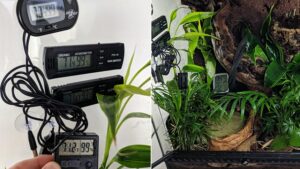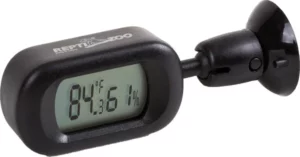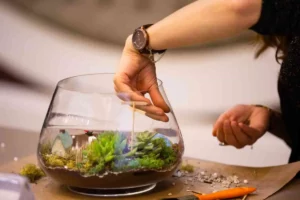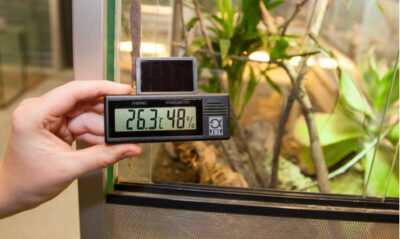Creating the ideal environment for your terrarium inhabitants is crucial for their well-being, and one key instrument that plays a pivotal role in this task is the hygrometer. Understanding where to place the hygrometer in terrarium is essential for accurate measurements and maintaining optimal humidity levels.
Place the hygrometer in the middle of the terrarium, away from direct heat sources or drafts, at a level where your reptile or plants primarily reside. However, in this guide, we will explore the significance of proper hygrometer placement and how it contributes to the overall health and thriving ecosystem of your terrarium.
Whether you are a seasoned terrarium enthusiast or a beginner embarking on this captivating journey, discovering the ideal positioning for your hygrometer is a fundamental step towards creating a habitat that mirrors the natural conditions your plants and animals require.
Let’s delve into the importance of hygrometer placement and unlock the secrets to achieving the perfect balance in your terrarium environment.
Importance of monitoring humidity in a terrarium

Monitoring humidity in a crested gecko tank is crucial for maintaining a healthy environment for the plants and animals within it. As someone with experience, you likely understand that different species of plants and animals have specific humidity requirements that mimic their natural habitats.
Here are some key reasons why monitoring humidity is important:
- Mimicking Natural Environment:
-
- Many species of plants and animals, especially those from tropical or rainforest habitats, thrive in specific humidity levels. By monitoring and maintaining the humidity in the terrarium, you can recreate the conditions that these organisms are adapted to in the wild.
- Respiratory Health:
-
- Reptiles, amphibians, and certain insects have respiratory systems that are highly sensitive to changes in humidity. Maintaining the right humidity levels ensures proper respiratory function, preventing respiratory issues that may arise in drier or excessively humid conditions.
- Hydration:
-
- Plants and animals in a terrarium obtain water through the air in addition to their food and water sources. Proper humidity levels are essential for preventing dehydration, especially for species that have evolved to absorb water through their skin or specialized structures.
- Molting and Shedding:
-
- For reptiles and arthropods, maintaining the right humidity is crucial during molting or shedding. Insufficient humidity can lead to difficulties in shedding skin, potentially causing injuries and complications.
- Reproduction:
-
- Many species require specific humidity conditions for successful reproduction. This includes creating appropriate nesting sites, maintaining moisture for eggs, and ensuring proper conditions for the development of offspring.
- Behavioral Well-being:
-
- Animals in captivity may exhibit stress or abnormal behaviors if kept in conditions that deviate significantly from their natural habitat. Proper humidity contributes to the overall well-being of the inhabitants, allowing them to display natural behaviors and reducing stress.
- Preventing Mold and Fungal Growth:
-
- Excessive humidity can lead to the growth of mold and fungi, which can be harmful to both plants and animals. Monitoring and controlling humidity levels help prevent these issues, maintaining a clean and healthy environment.
- Thermoregulation:
-
- Some species rely on humidity for thermoregulation. Maintaining the right humidity levels can aid in temperature regulation, ensuring that animals can effectively control their body temperature through behaviors like basking or seeking shelter.
Purpose of placing a hygrometer in a terrarium
Placing a hygrometer in a terrarium serves the purpose of measuring and monitoring the humidity levels within the enclosure. A thermo hygrometer is an instrument that is specifically designed to measure the relative humidity in the air.
In a terrarium, which is a controlled environment for plants, animals, or specific ecological conditions, maintaining the right humidity level is crucial for the well-being of the inhabitants and the success of the ecosystem.
Here are a few reasons why placing a thermo hygrometer in a terrarium is important:
- Health of Inhabitants: Different species of plants and animals have specific humidity requirements for optimal health and well-being. By using a hygrometer, you can ensure that the humidity levels in the terrarium are within the recommended range for the particular species you are housing.
- Preventing Mold and Fungal Growth: Excessively high humidity guage levels can create a favorable environment for mold and fungal growth. This can be detrimental to both plants and animals. Monitoring humidity allows you to take corrective measures if levels become too high, such as improving ventilation or reducing water sources.
- Behavior and Reproduction: Some species of plants and animals may exhibit specific behaviors or breeding patterns in response to changes in humidity. By maintaining the appropriate humidity levels, you can encourage natural behaviors and potentially support successful reproduction.
- Temperature Regulation: Humidity is closely linked to temperature regulation in many terrarium setups. The combination of temperature and humidity influences the overall climate within the enclosure. Monitoring both factors helps create a stable and suitable environment.
- Preventing Respiratory Issues: Inadequate humidity levels can lead to respiratory problems in certain species. For example, some reptiles require a specific level of humidity to prevent dehydration and maintain proper respiratory function.
By regularly checking the hygrometer readings, terrarium enthusiasts and caretakers can make informed adjustments to the environmental conditions, ensuring the well-being and thriving of the organisms within the enclosure.
Factors Influencing Humidity in a Terrarium

The humidity in a terrarium is influenced by various factors, and maintaining the right balance is essential for the health and well-being of the plants and animals within the enclosure.
Here are some key factors that can influence humidity in a terrarium:
- Watering Practices: The frequency and amount of watering directly impact humidity levels. Overwatering can lead to high humidity, while underwatering can result in low humidity. The type of substrate used in the terrarium also affects water retention.
- Substrate Choice: The substrate or bedding material in the terrarium plays a crucial role in moisture retention. Different substrates have varying water-holding capacities, affecting how much water is available to contribute to the humidity in the environment.
- Ventilation: Proper ventilation is essential to prevent the buildup of stagnant air and excessive humidity. Good airflow helps maintain a healthy balance and prevents the development of mold and fungi.
- Terrarium Size and Design: The size and design of the terrarium impact how well it retains moisture. Larger enclosures may require more extensive misting or watering to maintain adequate humidity levels. The presence of a lid or cover can also influence humidity retention.
- Temperature: Humidity is closely related to temperature. Warmer air can hold more moisture than cooler air. As the temperature increases, the air’s capacity to hold water vapor also increases, potentially leading to higher humidity. Conversely, cooler temperatures may result in lower humidity levels.
- Water Features: The inclusion of water features, such as ponds or water bowls, can contribute to humidity. Evaporation from these water sources increases the moisture content in the air. However, it’s crucial to monitor and adjust these features to prevent excessively high humidity.
- Lighting: The type and intensity of lighting can affect temperature and, consequently, humidity. Certain light fixtures generate heat, impacting the terrarium’s microclimate. It’s essential to consider the lighting needs of the plants and animals while managing humidity.
- Climate and Ambient Conditions: The external environment and climate conditions can influence the terrarium’s humidity. For example, if the room where the terrarium is located is naturally humid, it may affect the enclosure’s humidity levels.
- Plant Selection: The types of plants in the terrarium can influence humidity. Some plants release moisture through a process called transpiration, contributing to higher humidity levels. Others may absorb more moisture from the environment, potentially lowering humidity.
Regularly monitoring these factors and adjusting environmental conditions as needed, with the help of a hygrometer, ensures that the terrarium maintains the appropriate humidity levels for the specific needs of the organisms within it.
Ideal Humidity Levels for Different Terrariums
The ideal humidity levels for different types of terrariums depend on the specific needs of the plants and animals that inhabit them. Here are general guidelines for each type of terrarium:
Tropical Terrariums:
- Humidity guage Range: 70% – 90%
- Temperature Range: 75°F – 85°F (24°C – 29°C)
- Additional Considerations: Tropical plants and animals typically thrive in high humidity environments. Regular misting, a water source (such as a substrate that retains moisture), and good ventilation to prevent stagnation are essential. Proper lighting to simulate tropical daylight conditions is also important.
Arid Terrariums:
- Humidity Range: 20% – 40%
- Temperature Range: 70°F – 90°F (21°C – 32°C)
- Additional Considerations: Arid terrariums, designed for plants and animals from desert environments, require low humidity levels. Well-draining substrate, minimal watering, and proper ventilation are crucial. Heat sources should be provided to create a warm, arid climate.
Temperate Terrariums:
- Humidity Range: 40% – 60%
- Temperature Range: Varies depending on the specific plants and animals; typically between 60°F – 75°F (15°C – 24°C)
- Additional Considerations: Temperate terrariums aim to replicate the conditions found in temperate climates. The humidity level is moderate, and the temperature can vary based on the specific requirements of the inhabitants. Good ventilation and a balance between moisture and dryness are key.
You should keep in mind that these are general guidelines, and the specific needs of the plants and animals in your terrarium may vary. Always research and understand the requirements of the species you are housing, as well as any particular microclimates within the terrarium.
Types of Hygrometers for Terrariums
There are several types of hygrometers available for monitoring humidity levels in terrariums. Each type has its advantages and may be suitable for different terrarium setups. Here are common types of hygrometers:
Analog Hygrometers:
- Ideal for measuring and monitoring temperature and humidity
- Features an attractive design, stainless steel case and flange mounting
- Temperature measurement range is 30 to 250 degrees F (-1 to 121 degrees C) and...
-
- Description: Analog hygrometers are traditional, mechanical devices with a dial or needle that indicates the relative humidity. They often come combined with a thermometer.
- Pros: Easy to read, simple to use, and cost-effective.
- Cons: May have lower accuracy compared to digital hygrometers, and they might require occasional calibration.
Digital Hygrometers:
- Face Icon Comfort Indicator: Humidity temperature gauge features face icons to...
- Highly Accurate Sensors: This temperature humidity sensor features a high accuracy of...
- Fast Refresh Rate: This digital indoor thermometer refreshes every 10 seconds to...
-
- Description: Digital hygrometers use electronic sensors to measure and display humidity levels digitally. Many digital hygrometers also include additional features such as temperature readings.
- Pros: Generally more accurate than analog hygrometers, often have additional features, and may offer precise readings.
- Cons: Some low-quality digital hygrometers may drift over time, and they may require occasional calibration.
Wireless Hygrometers:
- Multi Channel Hygrometer: The hygrometer thermometer come with 1 main unit (built-in...
- Backlight and Touchscreen: Remote thermometer features touchscreen and 4'' high clear...
- Trend Indicator and High Low Records: Humidity meter displays indoor outdoor...
-
- Description: Wireless hygrometers are digital devices that transmit humidity and temperature data wirelessly to a remote display unit. They are useful for monitoring conditions in different parts of a large terrarium or in multiple enclosures.
- Pros: Convenient for remote monitoring, especially in larger setups.
- Cons: May be more expensive than basic digital or analog hygrometers.
Data-Logging Hygrometers:
-
- Description: Data-logging hygrometers can record and store humidity and temperature data over time. This allows you to analyze trends and fluctuations in the terrarium environment.
- Pros: Useful for tracking long-term trends and identifying patterns.
- Cons: Typically more expensive, and not necessary for all terrarium setups.
Infrared Hygrometers:
-
- Description: Infrared hygrometers use infrared technology to measure humidity levels. They are often used in industrial and scientific settings but may also be suitable for certain terrarium applications.
- Pros: Can measure humidity without physical contact with the air, which can be advantageous in specific situations.
- Cons: May be more expensive and may have limitations in terms of accuracy for terrarium use.
When choosing a hygrometer for your terrarium, consider the specific needs of your setup, the accuracy required, and your budget.
It’s also a good idea to check customer reviews and recommendations to ensure that the hygrometer you choose is reliable and suitable for the conditions in your terrarium. Regular calibration, if necessary, will help maintain the accuracy of the hygrometer readings over time.
Where to place a hygrometer in a terrarium?

The placement of a hygrometer in a terrarium is crucial to ensure accurate readings that represent the overall conditions experienced by the plants and animals within the enclosure. Here are some guidelines on where to place a hygrometer in a terrarium:
- Near the Center of the Enclosure:
-
- Place the hygrometer near the center of the terrarium, at a height where the majority of the plants and animals reside. This will provide a representative measure of the overall humidity in the main living area.
- Away from Direct Heat Sources:
-
- Avoid placing the hygrometer directly above heat sources, such as heat lamps or heat mats. Direct heat can affect the accuracy of the humidity readings. Instead, position the hygrometer in an area where it is shielded from direct heat emitter.
- In a Shaded Area:
-
- Ensure that the hygrometer is not exposed to direct sunlight. Direct sunlight can increase the temperature around the hygrometer and potentially affect humidity readings. Place it in a shaded area to prevent this interference.
- In the Vicinity of Water Sources:
-
- If your terrarium has water features, such as ponds or water bowls, consider placing the hygrometer in the vicinity of these areas. This will help you monitor the localized humidity around water sources.
- Avoid Corners and Edges:
-
- Steer clear of placing the hygrometer in corners or along the edges of the terrarium. These areas may have different airflow patterns and microclimates, leading to inaccurate readings.
- Consider Multiple Hygrometers:
-
- In larger terrariums or enclosures with distinct microenvironments, consider using multiple hygrometers to monitor different areas. This is especially relevant for multi-level or compartmentalized terrariums.
- Secure and Stable Placement:
-
- Ensure that the hygrometer is securely and stably positioned. This prevents accidental displacement and helps maintain consistent readings. Some hygrometers come with built-in stands or mounting options for secure placement.
- Regularly Check and Calibrate:
-
- Periodically check the hygrometer’s accuracy and calibrate it as needed. Calibration ensures that the hygrometer provides reliable and precise humidity readings over time.
By strategically placing the hygrometer in your terrarium, you can gather information about the overall humidity conditions, allowing you to make adjustments to maintain the ideal environment for the plants and animals within the enclosure.
Danger of wrong placement of hygrometer in terrarium
Placing a hygrometer incorrectly in a terrarium can lead to inaccurate humidity sensor readings, which, in turn, can have negative consequences for the well-being of the plants and animals within the enclosure. Here are some dangers associated with the wrong placement of a hygrometer:
- Misleading Humidity Information:
-
- Incorrect placement may result in the hygrometer providing inaccurate readings that do not reflect the true humidity sensor levels experienced by the inhabitants of the terrarium. This can lead to misguided decisions in terms of environmental adjustments.
- Mismanagement of Watering:
-
- If the hygrometer is not accurately positioned, it may give a false impression of the moisture levels in the terrarium. This can lead to inappropriate watering practices, such as overwatering or underwatering, which can impact the health of plants and animals.
- Inadequate Humidity for Certain Species:
-
- Different species within the terrarium may have specific humidity monitor requirements. Incorrect readings may result in an environment that does not meet the needs of certain inhabitants, potentially leading to stress, health issues, or even death.
- Failure to Recognize Localized Conditions:
-
- Placing the hygrometer in an area that does not represent the overall conditions of the terrarium may cause caretakers to overlook localized issues. For example, if the hygrometer is not near a water source, it may not accurately reflect the humidity levels around that area.
- Difficulty in Diagnosing Problems:
-
- Incorrectly placed hygrometers may mask or exaggerate problems within the terrarium thermometer. Caretakers may find it challenging to diagnose issues such as mold growth, respiratory problems, or other health concerns in the absence of reliable humidity monitor data.
- Wasted Resources:
-
- If the hygrometer readings are unreliable, caretakers might make unnecessary adjustments to the terrarium environment, leading to wasted resources, time, and effort.
To avoid these dangers, it’s crucial to carefully consider the placement of the hygrometer, taking into account the specific needs of the terrarium and its inhabitants. Regularly checking and calibrating the hygrometer, as well as using multiple devices in larger or compartmentalized terrariums, can contribute to more accurate monitoring of humidity levels.
In addition, caretakers should also be aware of the environmental factors that can influence humidity and adjust placement accordingly.
Conclusion
If you need to learn where to place hygrometer in terrarium to keep your reptiles safe, we have got the right information on this page for you. The proper placement of a hygrometer in a terrarium is essential for accurate humidity monitoring.
Placing it near the center of the enclosure, away from direct heat sources and sunlight, and considering proximity to water sources ensures representative readings. Incorrect placement can lead to misleading information, mismanagement of watering, and potential harm to the plants and animals within the terrarium.
Also, you need tRegular checking, calibration, and strategic placement contribute to maintaining a healthy and balanced environment for the terrarium’s inhabitants.




